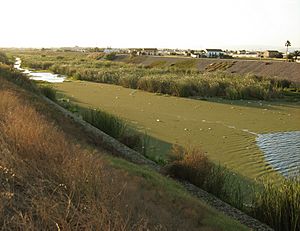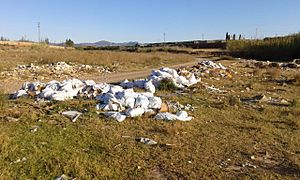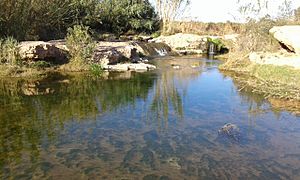Carraixet facts for kids

The Carraixet ravine is a natural waterway in the northern part of the Province of Valencia in Spain. It starts in Gátova and gathers water from the southern side of the Calderona mountain range. The ravine then flows into the Mediterranean Sea near the town of Alboraya. Sometimes, near where it meets the sea, it's also called the Olocau ravine or the Peralvillo ravine. Long ago, in a book called the Llibre dels feits, King James I of Aragon called it riu Sec, which means "Dry river". He mentioned it when talking about the Battle of the Puig.
Contents
Where Does the Carraixet Ravine Flow?
The Carraixet ravine begins in Gátova, west of the town. It collects water from springs like Alameda and Xarvilla on the south side of the Calderona mountains. It then flows through Olocau and heads southeast towards Bétera, where its riverbed becomes wider. Other smaller ravines, like the Cirer and Náquera ravines, join it.
Further along, it crosses Moncada and touches Alfara del Patriarca, acting as a natural border between these towns. It continues this role almost all the way to the sea. The ravine passes by Foios and Vinalesa, where the Palmaret Alto ravine joins it. From here, the Carraixet is channeled, meaning it flows through a specially built path. It goes through the Valencian areas of Benifaraig and Carpesa, then reaches Bonrepòs i Mirambell, turning east.
It passes Tavernes Blanques, a town on its right side. Near here, you can find a shrine dedicated to the Virgin of the Abandoned. This shrine was rebuilt in the same spot where it stood in 1447. The old road from Valencia to Barcelona crosses the ravine here. Finally, the Carraixet enters Alboraya. Even though the ravine is usually dry until this point, it starts to fill with water from different wells within the stream. The last part of the ravine is always full of water and is a popular spot for fishing. Close to where it meets the sea, there's another shrine that remembers a miracle involving fish.
Why is Canalisation Important?
The Carraixet ravine's riverbed is usually dry. However, when there are very heavy rains, it can become dangerous. This is because its basin (the area that collects rainwater) is large, and its slopes are steep. Major floods happened in 1949 and 1957. Also, because the ravine often has little water, many garden paths cross it between towns. These paths can be difficult and unsafe to cross if the ravine suddenly fills with water.
What Are the Carraixet's Tributaries?
Tributaries are smaller streams or ravines that flow into a larger one. The Carraixet ravine has a few:
- l'Olla Ravine
- Pedralbilla Ravine
- Cirer Ravine (which starts in the Calderona mountain chain)
A Green Path for Nature Lovers
In September 2015, a group called Compromís met at a place called Pont Sec ("dry bridge"). They wanted to protect the Carraixet ravine as a natural area. They aimed to highlight its beautiful landscapes, its important plants and animals, and its historical value. They also wanted to report the damage it was suffering. A politician from Compromís, Joan Baldoví, asked the government for money to turn the riverside into a "green road." This green road would have shade, easy access, signs for tourists, and places to relax.
Pont Sec: A Special Place
In the area of Moncada, the Carraixet ravine is also a path used by livestock. Sadly, this area has been damaged in recent years by rubbish dumps and uncontrolled farming. Because of this, many of the water plants have almost disappeared.
Between Pont Sec and Racó de Casans (near the Metropolitan Seminar), in the towns of Moncada and Foios, a special water channel called the Acequia of Bofilla helps. It brings water to keep the middle part of the ravine wet, even though it's usually dry. This helps birds build nests in the spring. You might even see moorhens hiding among the tall cattail plants. Many different kinds of plants also grow here.
Helping Nature: Environmental Volunteering
Since 2013, volunteers from Project Emys of Acció Environmentalist-Agró have been helping the Spanish pond turtles at Pont Sec. They use special traps to count how many Mauremys leprosa (the scientific name for these turtles) live there.
In 2015, 24 volunteers joined this effort at Pont Sec. They worked with local groups like the Colla Ecologista of Massarrojos, Col·lectiu Cultural Bòbila from Alfara del Patriarca, and Associació Cultural Macarella from Bonrepòs i Mirambell. They found five Iberian water turtles. Three of these had been counted before, but two were new! The volunteers also removed a Pond slider, which is a type of turtle that isn't native to the area and can harm the local turtles.
Towns Along the Carraixet Ravine
The Carraixet ravine flows through or near several towns:
- Gátova
- Marines
- Olocau
- Bétera
- Moncada
- Alfara del Patriarca
- Vinalesa
- Bonrepòs i Mirambell
- Tavernes Blanques
- Almàssera
- Alboraya
Images for kids
See also
 In Spanish: Carraixet para niños
In Spanish: Carraixet para niños





